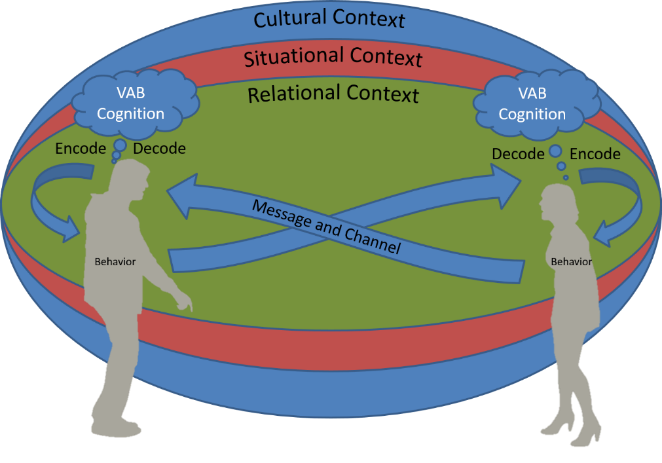
Communications Process
Communications Process
The communications process is an incredibly complex event – every time we communicate. It is based largely on our social identity and self-concept. Social identity theory[1] says that we will behave appropriately for whichever group is most salient at the time and our self-concept is how we see ourselves as others see us.
The stage and our audience
Conversations happen all the time, all around us, and even inside of us. The principles discussed in this module can be used regardless of the audience. If, as Shakespeare tells us, “all the world is a stage” then everyone is our audience.
- Intra-personal conversations are those that happen inside our heads.
- Inter-personal conversations are those that happen between two people.
- Small-Group conversations occur when more than two people are involved in the conversation.
- Large Group discussions happen when a speaker (or small group of speakers) interact with a larger audience

Contextual Layers
 Continuing with the role that group dynamics play in communication let’s discuss context and relationships. Every conversation has four layers of identity involved in it;
Continuing with the role that group dynamics play in communication let’s discuss context and relationships. Every conversation has four layers of identity involved in it;
The base layer for any conversation is how we see ourselves and ultimately define ourselves in that moment. Self-concept is the totality of the individual’s thoughts and feelings having reference to himself or herself as an object. Situational context is the feedback that active participants in a situation glean form their environment and other active participants. For example, the wink exchanged between two people who are in on an inside joke, a nod exchanged between two merging drivers, or the implicit understanding of the words, “go ahead” when one concedes the last slice of pizza to another. When parties to a conversation have an existing relationship, the Relational context may add a specific and clearly defined relational context. But when people simply play their role in an encounter an implicit relational context develops based upon their concept of social identity. This is known as, Cultural context. Cultural context is the layer of a conversation where our perceptions surrounding the roles we play in society influences the encounter.
Signal vs. Noise (Barriers)
Barriers (noise) to communication come in many forms. Largely, these barriers are based on perceptual differences in our sense making systems. Remember, this sense making system is developed through socialization and our self-concept. The majority of barriers are caused by bias in our world-view and the way we see ourselves ethnocentrically. That is, we view ourselves, our groups, and our environment as a constant against which all others are measured. When we experience something new we may experience cognitive dissonance. Any factor of our socialization that differs from another’s can cause this experience.
- Physical barriers include noise, obstacles, weather, etc.
- State of participants include physical, emotional, mental, and spiritual well-being
- Perceptual barriers are those specifically related to culture and socialization
- Other factors that might cause barriers to communications are thought patters, flow of information, assertiveness, candor / honesty, symbols, clothing and appearance, lack of trust, etc.
The source
As information flows from one party to the next in the communication process, one will always be the source and the other the destination.
As the source consider the following:
- Prepare yourself
- Is destination tuned in?
- Evaluate emotional status
- Use “I” messages
- Be specific
- Stay focused
Channels
Channels are the means through which messages are delivered.
- Written includes any sort of text or graphic based message
- Verbal includes spoken words and paralanguage; tone, volume, clarity, vocabulary
- Non-Verbal includes body language and physical contact
- Physical Space includes proxemics and eye contact
The Message:
The message is the lion’s share of the communications process. It includes all of, “what is said” and most of, “how it is said.” First, the sender encodes the message then the receiver decodes it. Both encoding and decoding are based on several factors that are dependent upon context, experience, and VAB. As the message leaves the sender it is adorned with all sorts of contextual implications. For example, the way a person is dressed while giving instructions might carry with it a certain implication of authority[2]. A difference in the sender’s emotional state (often referred to as, mood) compared to the receiver’s mood may have significant consequences in the wrapping and unwrapping of a message. We will discuss the concept of identity throughout this course. For the purpose of this module, identity orientation refers to the way in which individuals approach or manage to avoid the tasks of constructing and revising their self-identity.
One phrase often used in EO/EEO training is, impact versus intent.
Style:
The four styles of conversation are:
- Friendly, sociable, or playful
- Directive, persuasive, demanding, evaluative, blaming, or praising
- Speculative, tentative, uncertain, searching, reflecting, exploring or intellectual
- Disclosing, revealing, explicit, responsive, accepting, and aware
The Destination
On the receiving end of a sent message is the destination. This person or group of people have the responsibility of receiving it, passively or actively, and decoding it. Decoding can also be a deliberate and critical process or a dynamic and passive process. This occurs on a scale that begins with receiving. While receiving a message the listener simply absorbs the message with little or no awareness that it is impacting them. For instance, billboards and product placement on television. While attending to a conversation, our minds are switched on with intent of retaining the information for future use or easy decision making. Examples of attending might include; sitting through a lecture for the purpose of passing a test at a future date, or half-heartedly listing to a significant other and giving the placating, “mmmhmmmm” or “that’s interesting.” Interpreting a sent message requires the receiver to filter it through their own sense-making systems in an attempt to understand what the sender is trying to say. While understanding, on the other-hand is requires the listener to actively seek to understand the sender’s intent by filtering it through the sender’s sense making systems. This is done by actively participating in a conversation with the sender, asking good, clarifying questions. Responding is best done after understanding, although most readers can probably remember a time when they responded to a sender without fully understanding the message. Responding occurs when the listener transmits back to the sender with a meaningful response. Examples might include; “If I understand you correctly, the situation is effecting you in the following ways,” or, “I feel as though…” Finally, remembering takes place after effortful commitment to memory. Remembering details of a conversation and interactions with another person is received as a sign of respect. As a listener moves along this scale they become more active and effective listeners. This enables richer communication, more control, minimizes conflict, shows compassion, enables understanding, and improves memory.
[1] Learn more about social identity, YouTube.com/watch?v=USxOoPu5a_g
[2] The Milgrim Experiment, simplypsychology.org/milgram
